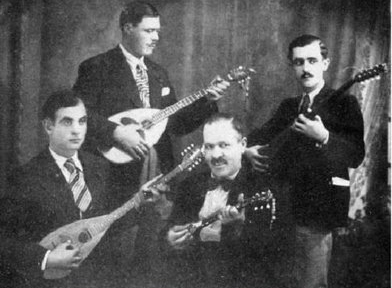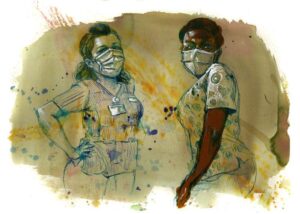“Rebetiko is more than music”

Dionysis Goularas was born in Parison April 15, 1969 from Greek parents and he has Greek and French nationality. He has spent his life between Athens, Thessalonikiand Paris. Some years ago he was living in Pariswhere he met his future wife, Gökçe. He graduated from the Electrical and Computer Engineering Department of Aristotle University in Thessaloniki. He accomplished his studies in Francewhere he obtained his Master and PhD degree in Computer Science at the University Paris XI. Together they took the decision to leave Parisand come to Istanbul. Today he is Assistant Professor at the Department of Computer Engineering of Yeditepe University in Istanbul. Since 2008 he is married with Gökçe Bayındır Goularas.
First of all I would like to ask him, how does he like living in Turkey…
“Turkey is full of pleasant surprises. First of all I was impressed by the Turkish hospitality. You cannot describe it, you have to experience it. And you can feel this hospitality everywhere: inside the shops, the restaurants, the working environment, inside the family. The family is very important in Turkey. Through this attachment to the family I saw the sensibility, the tenderness, and the respect to others that exists in Turkish people. Living in Turkey is a nice experience for me.” he says.
Here is our interview…
How would you describe being a son in law in Turkey?
It’s also a wonderful experience. My second name is “Enişte”. Maybe the TV series “Yabancı Damat” played a role. I guess it’s one of these cases where one wonders if art imitates life or life imitates art. In general, I feel good here. My Turkish family has embraced me with love and respect. I feel the same and I try to do my best for them.
How did you become interested in Rebetiko music?
As a Greek I had many opportunities to listen to Rebetiko music. What stimulated my interest was that Rebetiko is a very complex and dense music, despite the fact that it may appear to be simple. On the other hand when I play or hear this music, I can feel what we call in Turkish and in Greek “Keyif” or “Kefi”, “Dert” or “Derti”.
What is Rebetiko?
Rebetiko is more than music. In my opinion it is a story surrounded by music. The story cannot be separated from the music and the music cannot be separated from the story. This combination creates the Rebetiko mythology. According to different researchers and scholars, the myth of Rebetiko can start from the Byzantine Empire with the warriors of the borders named “Akrites” or from the outsiders of the 19th and 20th century living in Greece and Turkey. Others consider that Rebetiko express the rebel nature of Greeks. The important thing to remember about Rebetiko is that it is an URBAN MUSIC raised in Greek cities likeAthens,Piraeus andThessaloniki and a big part of its roots are in Athens,Izmir andIstanbul. But its roots go also deep inside the Greek folk and Byzantine tradition.
τσιτσανης νινου ,συννεφιασμενη κυριακη ,tsitsanis ,ninoy
When Rebetiko starts?
When we are talking about the music of Rebetiko, it is generally accepted that the starting date is 1922 despite the fact that the term “Rebetiko” exists in disk labels before that date. Nevertheless, some important researchers consider that Rebetiko is starting 10 years later and the decade before is a preparation. Personally, I consider that it starts in 1922 because I don’t take into account only strict musicological criteria. But the borders are still not clear. Today we can find CD collections called “Rebetika” with songs recorded before 1922…
Το μινορε του τεκε – Ιωαννης Χαλκιας
Which are the periods of Rebetiko?
Today it is generally considered that Rebetiko has 3 periods. The first one starts in 1922 and finishes in 1932 despite the fact that songs of this period are produced also in the following years. In 1922, after the defeat of the Greek Army in Turkey, tens of thousands of Greeks Christian Orthodox left Turkey and went to Greece. Many more have followed after the Lausanne Treaty. And they brought their music with them. This music is not the same as it was before, because new items related to their new life and the war experience were added. We call the songs of this period “Smyrneika”, that means songs of Izmir. The addition of new subjects and the different conditions of their creation is the reason why we distinguish them from the songs made in Izmir and Istanbul before 1922, even if they are similar. P. Toundas, V. Papazoglou, A. Hatzixristos, R. Eskenazy, A. Tomboulis, D. Semsis are some representative artists of this period.
The second period is called the classical period.
Πέντε χρόνια δικασμένος Βαγγέλης Παπάζογλου
It starts in 1932 and ends in 1942. In that period the bouzouki and the baglamas (a small instrument with the form of bouzouki but with the size of the Turkish tzoura) are the main musical instruments. Markos Vamvakaris is the “father” of this period. We call these songs “Peiraiotika”, meaning songs ofPiraeus, because they were made mainly inPiraeus. They are based on the tradition of previous urban songs of the outsiders called “mourmourika” or “adespota”. But there is a strong interaction between the “Peiraiotika” and “Smyrneika”. During this period the “Smyrneika” songs fade out and the “Peiraiotika” arise. Other representative artists besides Vamvakaris are G. Batis, S. Keromytis and S. Pagioymtzis.
The third period starts in 1942 and ends around 1952.
Μαρκος Βαμβακαρης – Φραγκοσυριανη
Some researchers believe that this period may be extended because some Rebetika songs were written even later. A censorship in the contents and in the style of music applied in 1936 by the dictator I. Metaxas, and the experience of the Second World War and the Greek Civil War has changed the style of the music. The bouzouki is still dominant but the Anatolian style of music is fading out. Representative artists of this period include among others V. Tsitsanis, G. Papaioannou and A. Kaldaras.
ΣΑΝ ΑΠΟΚΛΗΡΟΣ ΓΥΡΙΖΩ – ΣΩΤΗΡΙΑ ΜΠΕΛΛΟΥ & ΤΣΙΤΣΑΝΗΣ
Briefly during these 3 periods we can see a transformation of the Rebetiko music. In the beginning we use Ottoman makams and instruments that can play Anatolian music like oud, kanoun, violin etc. After that, we use the makams but with well-tempered instruments like bouzouki. Finally, the makams are almost abandoned and the music is westernized. There is of course a touch of Anatolian style music. This may be a simplistic description, but it gives you a general idea about the changes that took place in each period. We should also mention that inside the Rebetiko music we can find some important artists with Armenian or Jewish origin like Agapios Tomboulis (Agop Tomboulian), Marika Ninou (Evangelia Atamian), Stella Haskil and Roza Eskenazy (Sara Skenazy).
So, what is the story after all these?
It is the story of two populations: The Greeks (Rum) of Anatolia, and the Greeks (Yunan) of the Balkans. They were united for the first time in the Greek cities in the beginning of the 20th century. Inside these cities they lived together, they created together, they sang together. And at the end the Greek of Anatolia becomes a Balkan Greek. Rebetiko is the last musical photo of this transformation. And inside this music we can find traditions, attitudes, behaviors, that can go deep in the past.
During your research were there things that you were surprise to find out?
How condensed and rich is Rebetiko. Inside the Rebetiko songs we can find a “syrtos” melody that goes centuries back or a zeybek song from Kastamonu. These simple songs also describe many interesting stories. These stories seem to appear for the first time in songs recorded in the 20th century. In reality many of them are very old in the region. Rebetiko is based a lot on the anonymous musical tradition of Greece and Turkey. A lot of composers just took this tradition and recorded it for the first time. But they have also made additions. A classical example is the Greek zeybekiko that was created mainly inside the Rebetiko music. It is based on the zeybek of Turkey. But new forms and musical styles were added in a way that now zeybekiko is a new form of music that can be easily distinguished from the folk songs of zeybek danse in Turkey.
What does affect this music…? Could you tell us a little bit about that?
Rebetiko speaks directly to the heart. It’s a kind of music that you can feel even if you don’t understand the words. It speaks more to people of our region because it’s a part of the Anatolian and Balkan music. There is no point in telling more; the best thing for one who wants to understand its effects would be to listen to the music itself!
The original Misirlou – Μισιρλού (Τέτος Δημητριάδης -1927)
Any Turkish influences?
They are many Turkish influences in Rebetiko. For example you can find the basic melody of “Telgrafin tellerine”, a common Greek-Turkish song, in the song “Aeroplano” of P. Toundas. The use of Turkish makams by itself is also a strong influence. The Greek well-tempered makams called “Dromoi” (meaning “Ways” or “Roads”), even if they are something new, have mainly Turkish names and with few exceptions are based on the Turkish makams. It is not a surprise that during the censorship of I. Metaxas the use of some “Dromoi” and Turkish makams were forbidden, in an effort to westernize the music.
What is the relation between Greek and Turkish Music?
In my opinion we should see the Anatolian music as a whole. The Turkish makams themselves go back to the Arabic, Persian, Byzantine and ancient Greek tradition. Their names have mainly Persian or Arabic origin. Together with “Dromoi” they make part of the last makams produced by the rich culture of the region. Of course, from a strict musicological point of view it’s not correct to characterize “Dromoi” as makams because they are well-tempered. But the Rebetes used to call them also “makamia”.
Before and during the Ottoman Empire, Turkish and Greek music were growing together for centuries. People at that period were singing a song without giving attention if it was Turkish or Greek. Each nation had and has of course its musical corpus. But the influences exist because musicians and people love first of all music itself. They don’t really care about the origin of the music.
Before the Rebetiko music Greeks and Turks have created together keeping at the same time their own musical personality. In Rebetiko this coexistence exists to a certain point. We can understand this coexistence easily by the fact that the Turkish music in the central and east Anatolia in general has different rhythms, musical forms and style compared to the music in the west.
What is the tradition of Rebetika songs?
It is the whole tradition of the region from a Greek point of view. Rebetiko embraces many cultures but in the end it gives birth to a different interpretation of the same tradition. Some researchers are focalized to some particular aspects like the life of the outsiders or to specific instruments like bouzouki in order to define and understand Rebetiko. Even if bouzouki is widely used to these songs and the outsiders played also a fundamental role, such approaches will lead to a local minimum, to a restricted understanding of Rebetika songs. We should not forget that in the beginning of the 20th century we record for the first time the songs of the region. The composers create of course new songs but they also record under their name songs taken from the rich cultural tradition that they have found.
Βαγγελης Σοφρωνιου – Ο Μανωλης ο Χασικλης
What does Rebetis mean?
We are not sure about the etymology of the word “Rebetis”. Researchers are not sure if it has Persian, Turkish or Greek origin. Maybe the etymology of the Greek word “rembomai” meaning “wandering around” can describe better the deepest meaning of the word. The confusion came because scholars and researchers have established this term around 1947. The word Rebetis or Rebetiko even if it has existed before, was not used at that period from the Rebetes. But we can find this word in a few Rebetika songs and in some disk labels with a different kind of music! The Rebetes defined themselves with different terms like “Mangas” and they called their music “Laiko Tragoudi”, Mangika”, etc.
Who is a Rebetis?
There is a big mythology about the people we call Rebetes. In general a Rebetis is a complex figure that takes influences from the region deep in space but also in time. InGreece we use the word Rebetis in order to describe a man that follows a particular way of life that is not the conventional one. Very often they call them outsiders. Some define their space as underground because they refuse to place them outside society. A Rebetis at that period has a code of honor, he can be a musician who plays the Rebetiko music or he can be a fan of this music. Rebetis is on the top of an iceberg of a regional tradition formed by the Greek outsiders of 19th century called the “koutsavakides”, generally the outsiders of the beginning of 20th century, the kabadayi, the rebels, the zeybek and any kind of people that do not accept the local power or society by applying their own rules.
In reality, during the years 1922-1952 a lot of Rebetes were married and had normal jobs. Some of the people who composed Rebetiko music were accomplished musicians and artistic directors in recording companies like S. Peristeris and P. Toundas. In general a Rebetis respects everyone but he reacts when he is not respected. And he is loved and estimated by the people even if he has a different way of life. Rebetis is attractive as a figure because he represents the changes that we should do in our life in order to live with our ideas, but we cannot. Even if a lot of Rebetes were unhappy just because they followed this particular way of life. A poem of K. Kavafis describes the consequence for those few people who say the “BIG NO” to things that they do not agree with. This is the spirit of Rebetes. But it is not a revolutionary movement. It is a personal way of life.
What is the relation of Rebetes with religion?
We can find influences from many religions. First of all, let’s start from the way of life of the Bektashi order. Right now I am not in measure to judge how big it is. For example, a respectful and loved friend is described with the word “dervisis” that comes from the word “derviş”. Some of the Rebetes are smoking the nargile in places named “teke”. This event is accompanied very often with music played by instruments with 3 strings. We should not forget that the main part of the voluntary islamization in the Balkans was made through the Bektashi order, where Christians entered in contact with a “softer” version of Islam, from a Christian point of view. In general the Bektashi order was very respected by the Christians. It is a subject that needs to be investigated.
Μαρκος Βαμβακαρης – Εφουμερναμε ενα βραδυ
On the other part “Panagia” the Holy Mother of Jesus is present to some of these songs describing the attachment of Rebetes to this emblematic Christian figure. Rebetes consider themselves Christians but in their own way. We can find also elements of the ancient Greek religion especially in the case of songs dealing with death. In the Rebetika songs there is noParadise, an idea similar to the beliefs of Ancient Greeks. Everything ends when death comes and the Rebetis talks personally with Death using his ancient Greek name “Haros”. A Rebetis goes to “Adis” the ancient Greek underground place for the souls. And there he continues to sing and play his bouzouki. His music can be heard up to the earth by the other Rebetes who are proud of him.
Γιαννης Παπαιωαννου – Πεντε Ελληνες στον Αδη
Zorba the Greek is a Rebetis?
“Zorba the Greek” may be seen as a man who follows a “Rebetiko” style of life. The dance “Syrtaki” was first created for the needs of the movie and has its roots in the Hasapiko dance, one of the principal musical forms of Rebetiko music, together with Zeybekiko. In the movie, Zorbas dances a kind of zeybekiko in his own ecstatic way. Generally this movie explores the myth of Rebetis from a personal point of view. We should also mention that in the movie Zorbas is “wandering around”.
How does population exchange affect the music?
The population exchange in my opinion is the key element for the creation of Rebetiko songs. Without the population exchange Greek artists from Greece and Turkey will have never met in order to create music together. Rebetiko is the result of this event. When the consequences of this event are decreasing, the music itself is decreasing.
What is Rebetiko after all?
Rebetiko can be seen as a hybrid of east and west, a music that contains both the east and the west. The main instrument of this music, the bouzouki, is a hybrid instrument: half tambouras, half mandolin. The Greek makams named “Dromoi” are hybrid: Ottoman makams played in well-tempered instruments. The fusion of east and west in order to produce something new is an old and fundamental characteristic of the Greek culture. Rebetiko is also a musical witness of the Greek people of Anatolia and the last musical witness of the coexistence with the Turkish people and culture.
How Rebetiko music can touch a Turk?
Personally I believe that Rebetiko music and especially its first period is one of these elements that unite Greeks and Turks. In Rebetiko each one can see a part of his musical culture and not only. The Rebetiko music is joy and pain mixed together: “Keyif” and “Dert”, “Kefi” and “Derti”. Doesn’t this ring a bell?
(Turkish Journal)




